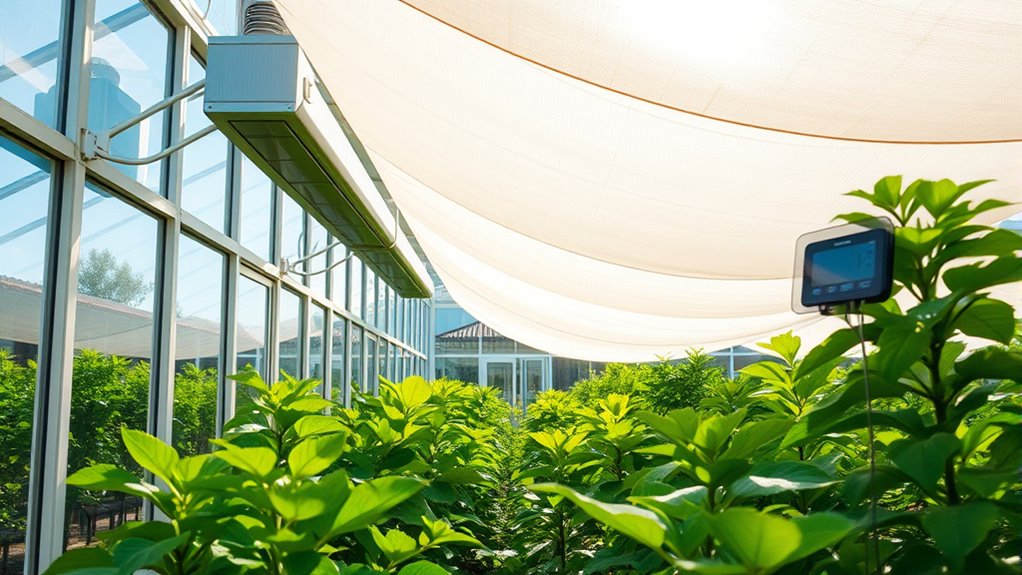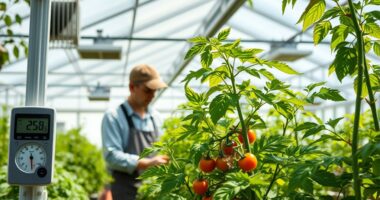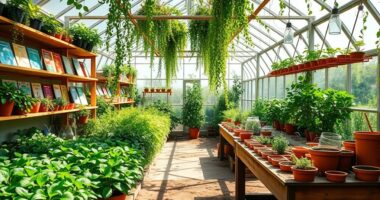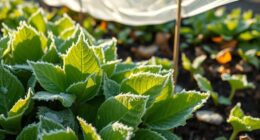To keep your greenhouse cool and functional during summer, ensure proper ventilation by using roof vents, exhaust fans, and cross-ventilation techniques, which help remove hot air and introduce cooler airflow. Enhance airflow with oscillating fans and consider shading options like shade cloths or retractable systems to block excess sunlight. Combining ventilation with shading effectively reduces heat buildup and maintains ideal conditions. Want to discover more ways to protect your plants during the heat? Keep exploring.
Key Takeaways
- Use strategic ventilation systems like roof and side vents with exhaust fans to remove hot air effectively.
- Incorporate automatic vent openers and cross-ventilation for consistent, hands-free temperature regulation.
- Install shade cloths, reflective materials, or retractable shading to minimize heat gain from sunlight.
- Enhance airflow with oscillating fans to prevent stagnant hot spots and maintain uniform temperature.
- Regularly monitor temperature and humidity levels to adjust cooling methods promptly and protect plant health.

As summer approaches, it’s vital to give your greenhouse the right care to guarantee healthy plants and a productive season. One of the most effective ways to do this is by managing the internal temperature, which can easily rise to uncomfortable levels without proper ventilation and shading solutions. Ventilation techniques are essential because they help regulate airflow, prevent heat buildup, and maintain ideal humidity levels. You should start by making sure your vents are functioning properly—whether they’re roof vents, side vents, or exhaust fans. Automatic vent openers can take the guesswork out of this process, opening and closing as needed. Cross-ventilation, where cooler air enters from one side and warmer air exits from another, is particularly effective. Installing oscillating fans can also improve air circulation within the greenhouse, preventing stagnant pockets of hot air that can stress your plants. Additionally, selecting the right ventilation methods can significantly enhance temperature regulation efficiency.
Shading solutions are equally important, especially during the hottest parts of the day. Consider using shade cloths or shade paint to block excessive sunlight without depriving your plants of necessary light. Shade cloths come in various densities, so choose one that filters out enough heat but still allows light to penetrate. Installing retractable shading systems gives you flexibility, so you can adjust the amount of shade depending on the weather and your plant needs. Reflective materials, like white paint or reflective films, can also help bounce sunlight away from the greenhouse, reducing heat absorption. This prevents the greenhouse from becoming a greenhouse oven and helps maintain a more consistent temperature.
Combining ventilation techniques with shading solutions creates a cooling effect that keeps the environment inside your greenhouse comfortable and healthy for your plants. Proper ventilation ensures hot air escapes, while shading minimizes heat gain from direct sunlight. Remember, the key is to strike a balance—adequate airflow to remove excess heat and moisture, coupled with shading to prevent overheating in the first place. Regularly monitor the temperature and humidity levels with a reliable gauge; this way, you can make real-time adjustments to your ventilation and shading systems. During peak summer days, it’s wise to open vents early in the morning and close them in the evening to retain cooler air overnight. Implementing these strategies not only protects your plants from heat stress but also promotes vigorous growth and healthy yields throughout the season.
Frequently Asked Questions
How Can I Prevent Pest Infestations During Hot Summer Months?
To prevent pest infestations during hot summer months, you should implement effective pest prevention strategies like maintaining cleanliness and sealing entry points. Use natural pest control methods such as introducing beneficial insects or applying organic repellents. Regularly inspect plants for early signs of pests, and remove any affected foliage promptly. By staying vigilant and combining these strategies, you can keep your greenhouse pest-free and healthy all summer long.
What Are the Best Ventilation Options for Small Greenhouses?
When choosing ventilation options for your small greenhouse, automated ventilation systems work best by opening and closing vents automatically, maintaining ideal airflow. Passive cooling methods, like vents or windows that you can open manually, also help reduce heat buildup. Combining these options ensures continuous airflow, keeping your greenhouse cooler and more functional during hot days. You get better temperature control and healthier plants without the hassle of constant manual adjustments.
How Often Should I Water Plants in a Heated Greenhouse?
You should establish a consistent watering schedule to guarantee proper plant hydration in your heated greenhouse. Typically, water your plants when the top inch of soil feels dry, which might mean watering every 1-3 days, depending on temperature and humidity. Adjust your schedule based on plant needs and soil moisture. Regular monitoring helps prevent overwatering or underwatering, promoting healthy growth and thriving plants year-round.
Are There Eco-Friendly Cooling Alternatives for Greenhouses?
Like a knight seeking greener pastures, you can explore eco-friendly cooling options for your greenhouse. Consider composting methods that generate natural heat reduction and install solar power options to run fans or misting systems sustainably. These alternatives help regulate temperature without harming the environment. By embracing such modern solutions, you keep your greenhouse cool and functional, all while reducing your carbon footprint and nurturing a healthier planet.
How Do I Monitor Temperature and Humidity Levels Effectively?
To monitor temperature and humidity effectively, you should use reliable sensors and regularly calibrate them to guarantee accuracy. Install digital sensors connected to a data logging system so you can track conditions over time. This allows you to identify trends, make adjustments, and maintain ideal greenhouse conditions. Consistent sensor calibration and data logging are key to responsive management, helping you keep your greenhouse cool and functional during hot summer days.
Conclusion
Now that you know how to keep your greenhouse cool and functioning during the summer, you’re well on your way to a thriving garden. Remember, staying ahead of the game is key, so don’t wait until things get too hot to act. With a little effort, you can beat the heat and keep your plants happy all season long. After all, a stitch in time saves nine—your garden will thank you for it!









